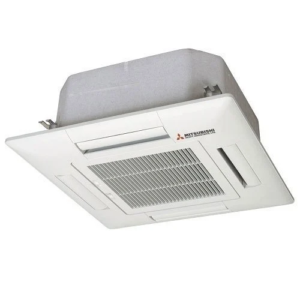Cassette air conditioners offer a unique solution for climate control, blending functionality with aesthetics. Unlike traditional wall-mounted units, they integrate seamlessly into the ceiling, providing effective cooling and heating while maintaining a sleek and unobtrusive design. This in-depth exploration delves into the world of cassette ACs, examining their operations, advantages, limitations, and crucial considerations before installation.
Understanding the Mechanism of Cassette Air Conditioners
Cassette air conditioners share core principles with split-system air conditioners. They consist of two primary components:
- Indoor Unit: This unit sits flush within the dropped ceiling, typically featuring a square grille that blends into the surroundings. Inside, air filters, a cooling coil, and a fan are housed.
- Outdoor Unit: Located outside the building, this unit contains the compressor and condenser coil, responsible for expelling heat extracted from the indoor space.

The Cooling and Heating Cycle
Similar to other air conditioners, cassette units utilize the principles of refrigeration to regulate temperature:
- Air Intake: Air from the room is drawn through the ceiling grille into the indoor unit.
- Filtration: The air passes through filters, removing dust, allergens, and other airborne particles.
- Cooling Process: A refrigerant absorbs heat from the filtered air, causing it to cool down. The refrigerant is then compressed, further increasing its temperature.
- Condensation and Heat Rejection: The hot refrigerant travels to the outdoor unit’s condenser coil. Here, a fan blows cool air across the coil, causing the refrigerant to condense back into a liquid state and releasing heat to the outside environment.
- Evaporation and Cool Air Distribution: The cooled refrigerant is then pumped back to the indoor unit’s evaporator coil. Here, the refrigerant absorbs heat from the indoor air passing over the coil, further cooling the air. A fan within the indoor unit blows this cool air back into the room through the ceiling grille.
- Heating (Optional): Some models incorporate heat pump technology for heating. In this mode, the process reverses, with the refrigerant absorbing heat from the outside air and releasing it inside the room.
Advantages of Cassette Air Conditioners
Cassette ACs offer several compelling advantages over traditional wall-mounted units:
- Discreet Design: Their integration into the ceiling makes them ideal for modern interiors or rooms where aesthetics are a priority. The only visible element is a square grille, minimizing visual obstruction.
- Even Airflow Distribution: The four-way airflow design ensures consistent cooling or heating throughout the room. This eliminates hot or cold spots often experienced with wall-mounted units.
- Powerful Cooling and Heating: Cassette units come in various sizes, with some boasting impressive cooling and heating capacities. This makes them suitable for large rooms or open floor plans.
- Quiet Operation: Modern cassette units, especially those with inverter technology, operate at relatively quiet noise levels. This minimizes disruption in living or working spaces.
- Additional Features: Some models offer features like variable speed operation for precise temperature control and potentially lower energy consumption. Remote control functionality provides convenience in adjusting settings without needing to directly access the unit.
- Space-Saving: Cassette units free up valuable wall space, especially beneficial in smaller rooms or areas where wall placement might be impractical.
Limitations to Consider
While offering numerous benefits, cassette units also have some limitations:
- Installation: Installing a cassette air conditioner requires a dropped ceiling. This can be a drawback in existing structures without one, as creating a dropped ceiling adds to the cost and complexity of installation.
- Professional Installation: Due to their placement and technical aspects, cassette units typically require professional installation by qualified technicians. This can be more expensive compared to installing a DIY wall-mounted unit.
- Maintenance Access: Regular cleaning and maintenance of the filters and internal components are crucial for optimal performance. Since the unit is hidden in the ceiling, accessing it can be more challenging and might require special tools or assistance.
- Cost: Cassette units are generally more expensive than their wall-mounted counterparts due to their larger size, advanced features, and specialized installation requirements.
- Limited DIY Options: Due to the complexity of installation, cassette units typically don’t offer many DIY options for those looking to save on installation costs.
Important Considerations Before Installation
Here are some important considerations before installing a cassette air conditioner:
Space Requirements and Building Suitability
- Dropped Ceiling: Cassette units require a dropped ceiling for proper installation. If your space doesn’t have one, creating one adds to the cost and complexity of the project.
- Ceiling Height: Ensure your ceiling height is sufficient to accommodate the cassette unit. Standard unit heights might not work with very high ceilings.
Capacity and Efficiency
- Room Size: Choose a unit with enough cooling and heating capacity for your room size. A qualified HVAC professional can help you determine the correct size based on square footage, ceiling height, and other factors.
- BTU Requirements: Understanding the BTU (British Thermal Unit) cooling and heating requirements of your space is crucial. Mismatched capacity can lead to inefficiency and discomfort.
- Energy Efficiency: Look for units with high Energy Star ratings to ensure energy efficiency and potentially lower running costs.
Installation and Maintenance
- Professional Installation: Due to their placement and technical aspects, cassette units typically require professional installation. Consider factoring in labor costs when budgeting.
- Maintenance Access: Regular cleaning of filters and potential maintenance of internal components are crucial. Think about how easily you can access the unit in the ceiling for servicing.
Cost Considerations
- Unit Cost: Cassette units are generally more expensive than wall-mounted units due to their size, features, and specialized installation requirements.
- Installation Costs: Factor in professional installation labor costs when budgeting for your cassette AC system.
- Long-Term Maintenance: Consider the ongoing costs of filter replacements and potential maintenance needs.
Additional Considerations
- Noise Levels: Check the noise level specifications of the unit, especially if it’s being installed in a bedroom or quiet area.
- Features: Decide on the features you prioritize, like variable speed operation, remote control, or dehumidification capabilities.
- Aesthetics: While generally discreet, consider how the cassette unit’s grille will blend into your existing ceiling design.
By carefully considering these factors and consulting with a qualified HVAC professional, you can determine if a cassette air conditioner is the right choice for your needs and ensure a successful and efficient installation.
Looking to install a commercial HVAC System or Duct work in your Business Area?
Contact Vipul Ac to learn about our HVAC Service
Call +91 9825636606 Today.
